Jont Allen’s ECE 298 JA Course Reinforces Engineering Math Fundamentals While Surveying the History of Mathematics
December 11, 2017
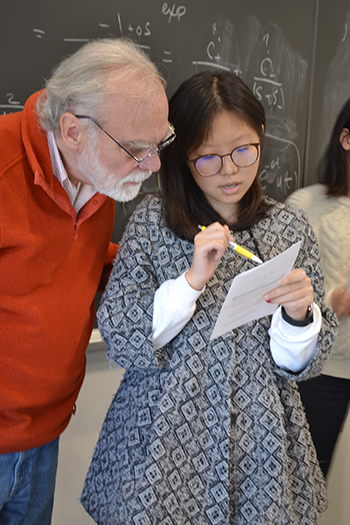
Jont Allen (left) helps an ECE 298 JA student work through a problem.
How well do AP students do on Illinois’ engineering math courses? To answer that question, about 12–15 years ago, a joint group of Illinois math and engineering professors studied the issue. While there is a strong correlation between AP scores of incoming students and how well they do in subsequent engineering math courses — students who get 5’s typically get A’s, 4’s get B’s, etc. — the study also discovered a great deal of variance and overlap between scores: though most students follow the norms, some end up getting A’s while others get D’s. Jont Allen, a professor in the Electrical and Computer Engineering (ECE) Department at Illinois, sees this enormous variability as a problem, so he set out to correct it. He created his own class, ECE 298 JA (his initials), to refresh incoming students in engineering math fundamentals while teaching them the history of mathematics.
While Allen was aware of the above study, it was his colleague, Steve Levinson, who first underscored the need, triggering the around 50 or so ensuing discussions they’ve had about the problem: These freshmen,” Allen relates, “they come in; they’ve AP-ed out, and they don’t do very well in their engineering courses, which is kind of shocking and concerning.”
He continues, “They’re obviously smart. They’ve AP-ed out of their calculus; they think they’re smart; they are smart, but then they come in and they don’t do very well.”
Why don’t they don’t do well? Allen has a theory: “The problem is, clearly—do I have data as to why? No, but I can tell you why—the high school education just isn’t up to college-level math. It’s very simple.”
He elaborates on why there is so much variability: “Because different schools have different levels. And the quality of the teachers is highly variable.” Some teachers simply prepare students for the AP exam, whereas others focus on topics not included on the exam.
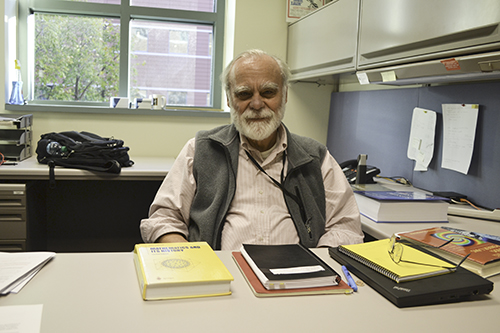
Jont Allen in his office with Mathematics and Its History, by John Stillwell (the yellow textbook on the left), that served as the inspiration for his course.
The different levels of preparedness in the incoming students prompted Allen to do something about it: to create a foundations course in math and physics that would challenge the more-prepared students while also allowing less-prepared students the time to catch up and feel more confident.
Allen teaches the class by presenting his students with a history of mathematics. His course is patterned after a book he had stumbled upon, Mathematics and Its History, by John Stillwell. “It inspired me. I just loved it. It really did a lot for me,” he admits, so he used it as a kind of template for his course, where he and his students explore a historical timeline for the progression of the seven fundamental theorems of mathematics.
So how far back in history does Allen go? China 5000 BC. Then he travels forward to the present by addressing the discoveries of a number of math greats that even non-engineers/mathematicians have most likely heard of: Euclid. Bernoulli. Pythagoras (to name a few). In the materials he’s created for his course, Allen includes several timelines explaining who did what, and when, and how people are connected.
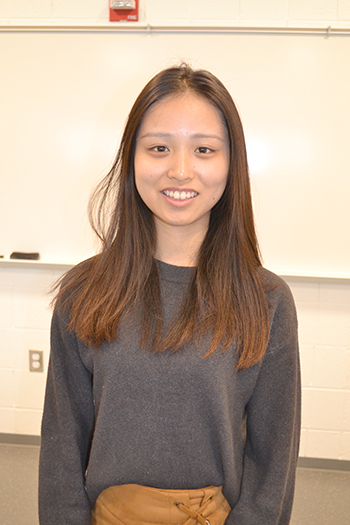
Yucheng Liang, an upperclassman in ECE 298 JA.
“I include the history to talk about who did what, and try to put a personality into it,” he remarks. “What I like is that no one's going to change the history.” Students still get the refresher course Allen set out to give them by “re-discovering” the theorems and how they came about. The historical component allows students to see how each theorem was developed and worked on by many people, as well as how the theorems spin off of each other. The cornerstone of modern mathematics is the Pythagorean Theorem, from which the other fundamental theorems originate.
Allen comments on the necessity and effectiveness of his class, “It's good because students are learning things they've never heard about before, and it's all very basic mathematics. This is five semesters of mathematics in a one-hour course. It's calc 1–3, linear algebra, differential equations, vector differential equations, and complex variables. I cram it all into this one semester, and it works. It stays at a pretty high level, and I emphasize seven fundamental theorem of mathematics.”
While the course was originally intended for freshmen, upperclassmen who have taken it as a review course have found that it gives them a context and helps them better understand previous math courses taken. Also, Allen encourages older students to take his class in order to ensure a steady supply of TA’s for coming semesters.
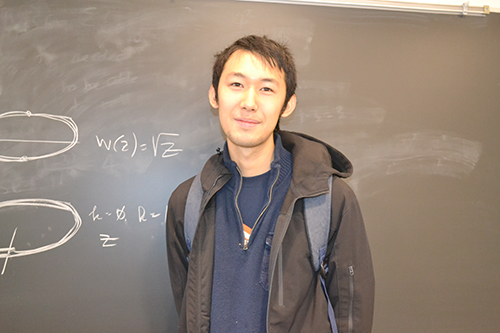
Above: Andy Sun, a senior in ECE 298 JA.
Below: Yucheng Liang (left) looks on as Jont Allen solves a problem on the chalkboard.
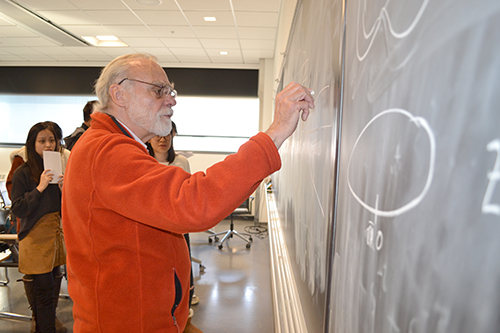
Take Andy Sun, a senior who took another class Allen taught, decided to take ECE 298 JA, and enjoyed it immensely. He comments, “For engineers we need a lot of math, and this class is a good review of math classes I've previously taken… Before, in class, I just learned how to use a formula and then plug in numbers. This gives more of a conceptual understanding of where everything comes and shows more of connection between everything.” Sun recognizes the need Allen's been emphasizing: engineers need a fundamental mathematics course at the college level to help them understand how their other classes function in relation to it.
Like Sun, Yucheng Liang, another upperclassman, had a very similar experience. “It [the class] helps me to better understand some of the courses I already took. It is just so helpful to me,” she acknowledges. Since the class combines the basic concepts of physics and engineering as well as math, it gives students both new and old a new perspective on what they have already learned, either in high school or other college courses. Instead of merely memorizing formulas, students can actually understand the derivation of formulas and which math fundamentals actually help them to do well in other classes.
When it comes to understanding the mathematics practicing engineers need in their craft, Allen knows from personal experience. In addition to being a professor at Illinois, he has also had an amazing career in the private sector.

Allen with a replica of the first transistor invented at Bell Laboratories in New Jersey on December 23, 1947.
He received his Ph.D. in Electrical Engineering from the University of Pennsylvania in 1970, and his primary research area is biomedical imaging, bioengineering, and acoustics. His 32 years at AT&T Bell Labs saw Allen specialize in cochlear modeling, auditory and cochlear speech processing, and speech perception. He and his team developed the first commercial multiband wideband dynamic range compression (WDRC) hearing aid, as well as many other significant advancements. In 2003, he joined the Illinois faculty in the ECE Department, teaching and working with his students on noninvasive diagnostic testing of cochlear and middle ear function.
Also, in keeping with his long tradition of trying to better people’s lives through his research, Allen has also been passionately researching another issue that has less to do with the ears itself but more to do with the ear-brain interface: the detection and identification of reading problems in young children. He works with Cynthia Johnson, in the department of Speech and Hearing Science, to study a group of children, half of whom are controls and the other half who are reading disabled. Allen remarks, “For the last 10 years, Cynthia and I did a study on these children. We demonstrated without any question that the reading disabled kids can't recognize some 20–30% of different speech sounds. They can't decode....” Essentially, though these children have completely functional hearing anatomy, their brains cannot identify the different phonemes, or sounds, of the language.
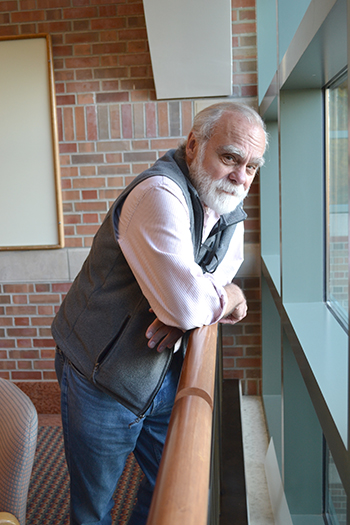
Jont Allen, ECE Professor.
According to Allen, “About 15% of the normal population in second grade has a reading disability. That's a lot of people. They go on, and they're years behind the class. And they end up dropping out of school unless they have parents who can afford to put some resources on them and try to get the problem fixed.” Allen wants to raise awareness about this disability because often these children are quite intelligent; they just get bored in class because they cannot understand what is going on. Many get behind in their classes and drop out simply because schools and teachers do not have the resources to identify the problem.
Allen makes one final plug for his ECE 298 JA course. In the words of its creator, it’s important because he’s seeking to help “…these young students who are very smart because they've AP-ed out. But when they come to take the courses, they don't do very well always. So we need some way to bring them all up to speed to reduce the variance. They come from all walks of life, they need to have a uniform way. It's a foundations course, and the ones I've talked to from past years are all now top in their class.”
Based on its positive impact so far, Allen encourages any student, regardless of age, who feels they need a refresher course in the basic fundamentals or mathematics to sign up for his class next semester!
Story by: Nick O'Connell, I-STEM Undergraduate Student Worker and a sophomore in Mechanical Science and Engineering, with Elizabeth Innes, Communications Specialist, I-STEM Education Initiative
Photographs by: Elizabeth Innes, Communications Specialist, I-STEM Education Initiative.
More: ECE, Faculty Feature, Undergrad Education Reform, 2017
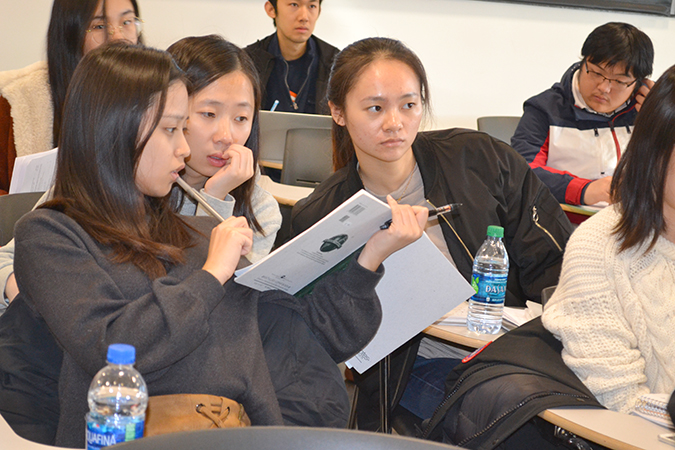
A group of ECE 298 JA students consult each other during class.













.jpg)
















